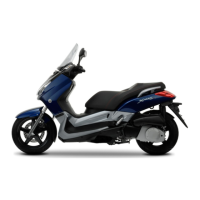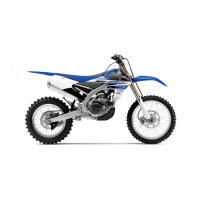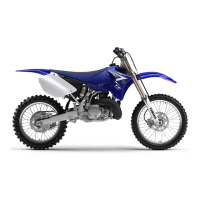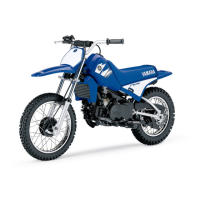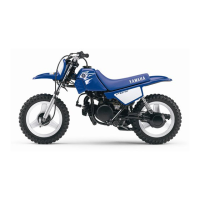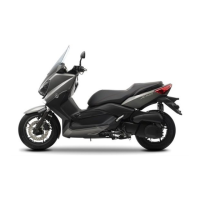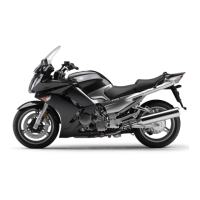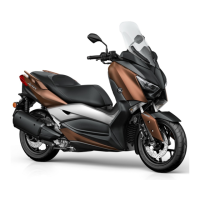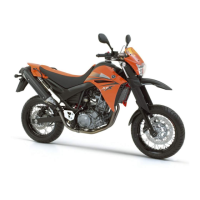Do you have a question about the Yamaha X-Max YP125RA and is the answer not in the manual?
Explains the meaning of WARNING, NOTICE, and TIP notations used in the manual for clarity and safety.
Caution regarding cleaning matte finish parts to prevent damage from harsh chemicals or brushes.
Guidelines for proper vehicle cleaning and maintenance to ensure longevity and optimal performance.
Instructions for storing the scooter properly to maintain its condition, covering both short and long-term needs.
Outlines the owner's responsibility for safe operation, operator qualifications, and fundamental safe riding techniques.
Details essential protective clothing and gear, emphasizing helmets, face shields, gloves, and footwear for rider safety.
Warns about carbon monoxide poisoning from exhaust and provides guidelines for safe vehicle loading and weight limits.
Discusses the use of genuine and aftermarket accessories, warning about potential safety hazards from modifications.
Covers tire maintenance, safe transport procedures, and warnings related to tire condition and usage.
Provides further tips for safe riding, including signaling, cornering, and navigating hazardous road conditions.
Identifies and locates various components on the left side of the scooter, including lights, levers, and storage.
Identifies and locates various components on the right side of the scooter, including grab bars, seat, and fuel cap.
Details the location and function of various controls and instruments on the handlebar and dashboard for operation.
Explains the vehicle's immobilizer system, its keys, indicator light, and critical usage precautions.
Describes the functions of the main switch, its positions (OFF, LOCK, IGNITION, P), and how to lock the steering.
Identifies and explains the function of various indicator and warning lights on the instrument panel.
Details the multi-function meter unit, its buttons, and display segments for monitoring vehicle status.
Provides step-by-step instructions for setting the clock on the multi-function display.
Explains the odometer and various tripmeters for tracking mileage, fuel usage, and maintenance intervals.
Explains the oil change and V-belt replacement indicators and how to reset them after service.
Covers various display modes including ambient temperature, battery voltage, fuel consumption, and speed.
Details the ambient temperature display and the function of the icy road warning indicator.
Explains the battery voltage display and the average/instantaneous fuel consumption modes.
Covers average speed display, warning message function, and the self-diagnosis device for error codes.
Explains the coolant temperature meter and actions to take in case of engine overheating.
Provides information about the optional anti-theft alarm system and where to get more details.
Identifies and describes the functions of switches located on both the left and right handlebars.
Explains the location and operation of the front and rear brake levers for applying the brakes.
Explains the Anti-lock Brake System (ABS) operation, activation, and limitations for rider safety.
Provides crucial safety warnings and step-by-step instructions for safely refueling the vehicle's fuel tank.
Information regarding the catalytic converter, including fuel recommendations and heat precautions.
Instructions on how to open and close the seat, and reminders about securing it before riding.
Details the location, operation, and limitations of the front and rear storage compartments.
Details how to adjust the spring preload on the shock absorber assemblies for desired ride comfort.
Explains the sidestand, its switch, and the ignition circuit cut-off system for enhanced safety.
Details checks for fuel level in the tank and fuel line for safe operation before riding.
Details checks for engine oil level, final transmission oil, and coolant level for proper system function.
Details checks for front and rear brake operation, fluid levels, pads, and hydraulic systems.
Details checks for throttle grip operation, free play, and cable condition for smooth throttle control.
Details checks for wheel damage, tire condition/pressure, and tightness of chassis fasteners.
Details checks for operation of instruments, lights, signals, switches, and the sidestand system.
Provides instructions and precautions for starting the vehicle's engine, including indicator light checks.
Details the steps and precautions for starting off from a standstill, including mirror adjustment and traffic checks.
Explains how to control vehicle speed by operating the throttle grip for acceleration and deceleration.
Provides essential advice and warnings on proper braking techniques, especially in wet or slippery conditions.
Offers advice on riding style, such as avoiding high speeds and idling, to improve fuel economy.
Provides crucial instructions for the engine break-in period to ensure longevity and proper engine wear.
Gives instructions and safety warnings for parking the scooter, including considerations for hot components and terrain.
Describes the location and purpose of the owner's tool kit, intended for basic maintenance and minor repairs.
Provides instructions for removing and reinstalling various body panels to access components for maintenance.
Details how to check the spark plug for condition, proper gap, and when it needs replacement.
Provides instructions for checking engine oil level and performing an engine oil and filter change.
Details how to check for oil leakage and change the final transmission oil at specified intervals.
Instructions for checking the engine coolant level and performing coolant changes.
Explains how to replace air filter elements and clean check hoses for engine performance.
Details how to check throttle grip free play, lubricate cables, and maintain throttle operation.
Emphasizes tire condition, tread depth, and replacement for optimal safety and performance.
Details checks for brake levers, pads, fluid levels, and procedures for changing brake fluid.
Explains how to check and lubricate control cables for smooth operation and prevent damage.
Explains how to lubricate the pivoting points of the front and rear brake levers for smooth operation.
Details checking and lubricating the centerstand and sidestand pivots for proper operation.
Instructions for checking the front fork's condition, operation, and oil leakage.
Explains how to check steering bearings for wear and wheel bearings for play or smooth operation.
Covers battery maintenance, charging procedures, safety warnings, and storage recommendations.
Explains how to replace blown fuses, locate the fuse box, and provides fuse specifications.
Provides instructions for replacing tail/brake lights, turn signal bulbs, and license plate bulbs.
Guides users through diagnosing and resolving common problems with starting and engine performance.
Provides diagnostic charts for common starting issues related to fuel, battery, ignition, and compression.
Explains how to diagnose and address engine overheating issues, including checking the cooling system.
Caution regarding cleaning matte finish parts to prevent damage from harsh chemicals or brushes.
General advice on cleaning the scooter, including recommendations for plastics, chrome, and exhaust systems.
Instructions for cleaning the windshield safely without scratching, using mild detergents or specialized cleaners.
Guidelines for short-term storage of the scooter, emphasizing a cool, dry place and protection from dust.
Detailed instructions for long-term storage, including fuel stabilization, engine protection, and battery care.
Lists the vehicle's overall dimensions, wheelbase, seat height, and curb weight.
Details engine type, displacement, bore/stroke, compression ratio, and transmission specifications.
Details chassis frame type, caster angle, trail, and front/rear suspension types and travel.
Lists tire sizes, manufacturers, wheel types, rim sizes, and tire pressure recommendations.
Details brake types, operation sides, and specified brake fluid for front and rear brakes.
Lists ignition system, charging system, and battery model information.
Details bulb types, voltage, wattage, and quantity for various lights and indicators.
Lists the amperage ratings for all fuses used in the vehicle's electrical system.
Explains the importance of vehicle identification numbers and model labels for parts ordering and registration.
| Brand | Yamaha |
|---|---|
| Model | X-Max YP125RA |
| Category | Motorcycle |
| Language | English |
